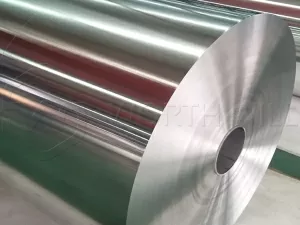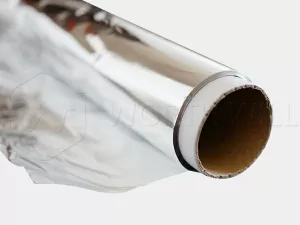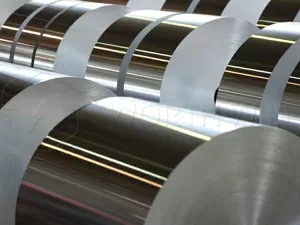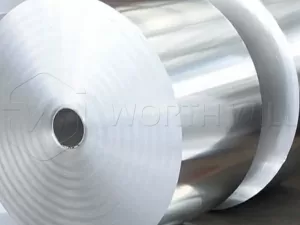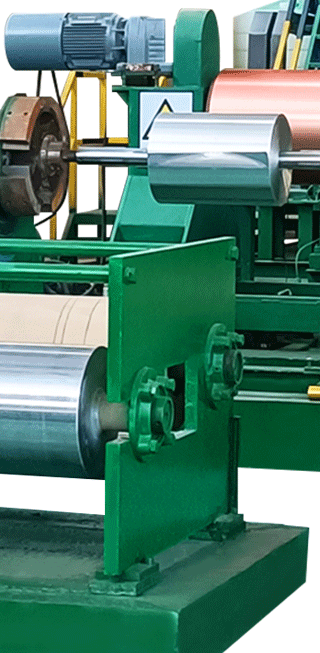Pharmaceutical Aluminum Foil
- Home
- Pharmaceutical Aluminum Foil
Pharmaceutical aluminum foil plays a crucial role in the safe and efficient packaging of medicines. It serves as a protective barrier, which preserves the quality, integrity, and effectiveness of pharmaceutical products.
Applications
Extensive application in the pharmaceutical industry, primarily in the following areas:
Blister Foil Packaging: Commonly used as the primary packaging material for blister packs. It provides exceptional barrier properties against light, moisture, oxygen, and other external factors.
Strip Pack Foil: Widely utilized for unit-dose packaging of tablets, capsules, and other solid dosage forms. The strip packs are convenient and ensure easy access to individual doses, while the aluminum foil maintains product integrity and extends shelf life.
Cold Forming Foil: Employed in the production of cold-formed blisters, which require high barrier protection against moisture, gases, and light. This specialized foil is ideal for moisture-sensitive medications.
Advantages
Barrier Protection: Acts as an impermeable barrier, shielding the medicines from moisture, oxygen and UV radiation.
Temperature Stability: Aluminum foil can withstand a wide temperature range, ensuring the stability and protection of pharmaceutical products during storage and transportation.
Easy Printability: Allowing for high-quality printing and labeling, enabling clear identification of medicines, dosage instructions, and other essential information.
Customizability: Customized to meet specific requirements, including different thicknesses, widths, and colors.
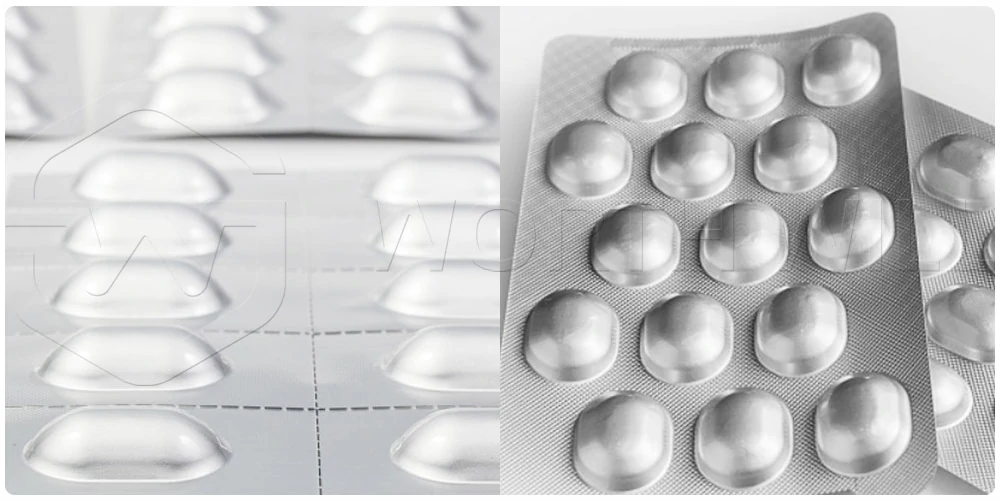
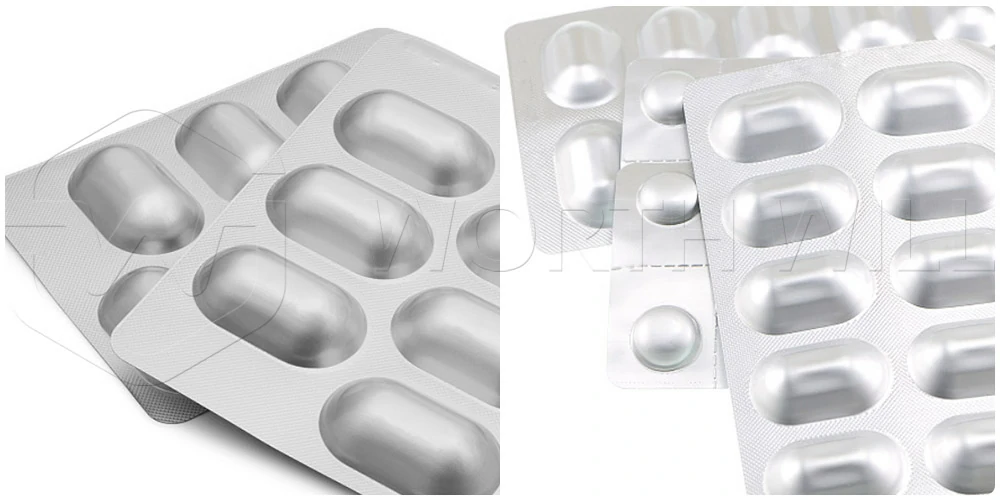
Pharmaceutical aluminum foils adhere to stringent quality standards to ensure reliable packaging solutions. Worthwill Aluminum, as a reputable manufacturer, offers the following specifications:
- Alloy: The pharmaceutical aluminum foil is typically manufactured using high-grade aluminum alloys, such as 8011, 8021, 8079, and 1235, which exhibit excellent barrier properties and formability.
- Thickness: The foil thickness ranges from 0.02mm to 0.05mm, depending on the specific application and customer requirements.
- Width: Worthwill Aluminum produces pharmaceutical foils with customizable widths, ranging from 100mm to 1200mm, allowing for versatile packaging solutions.
- Surface Treatment: The foils can be plain or coated with heat-seal lacquer for improved sealing and protection.
Why Medicines are Packed in Aluminum Foil?
The pharmaceutical industry chooses aluminum foil for packaging medicines due to the following reasons:
- Protection: Aluminum foil acts as a robust barrier, safeguarding medicines from moisture, oxygen, light, and external contaminants, thereby preserving their potency and shelf life.
- Safety: Aluminum foil is non-toxic and chemically inert, ensuring that the pharmaceutical product remains unaltered and free from potential leaching or contamination.
- Convenience: Aluminum foil facilitates easy opening, resealing, and administration of medicines.
- Brand Integrity: The use of aluminium foil in pharmaceutical packaging enhances brand visibility and integrity, contributing to the professional image and trustworthiness of the pharmaceutical product.
Classification of Pharmaceutical Aluminum Foil: Types and Uses
The versatility of pharmaceutical aluminum foil allows for its classification based on various properties and applications. Understanding these classifications helps in choosing the right type for specific drug packaging needs.
Hard Temper vs. Soft Temper Foil
- Hard Temper Pharmaceutical Aluminum Foil: This type is stiff and has high tensile strength. It’s ideal for blister packaging where the foil needs to hold its shape and provide structural rigidity. It’s often used as the “push-through” layer in blister packs.
- Soft Temper Pharmaceutical Aluminum Foil: More pliable and flexible, soft temper foil is commonly used for strip packaging, sachet packaging, and cold form foil. Its flexibility allows it to conform to various shapes without cracking, offering excellent barrier properties for sensitive drugs.
Bare Foil vs. Laminated Foil
- Bare Pharmaceutical Aluminum Foil: This refers to pure aluminum foil without any additional layers. While it provides excellent barrier properties on its own, it’s often laminated for enhanced performance.
- Laminated Pharmaceutical Aluminum Foil: This is the most common form for drug packaging. It involves bonding the aluminum foil with other materials like PVC, PVDC, PP, or paper using a special adhesive. These layers add specific functionalities such as heat-sealability, increased barrier protection, or improved printability. Examples include PTP aluminum foil (Push Through Pack), which is typically laminated with a heat-seal lacquer on one side.
The Alloy Story: What Makes it Strong?
The strength and barrier properties of pharmaceutical aluminum foil largely depend on the aluminum alloy used. While various alloys exist, specific grades are preferred for their purity and performance in medical applications.
Common alloys for pharma foil include:
- Alloy 8011: This is one of the most widely used alloys for pharmaceutical packaging. It offers excellent formability, high strength, and superior barrier properties. It’s often the base for blister packaging aluminum foil due to its reliability.
- Alloy 1235: Known for its high purity, Alloy 1235 is another popular choice. It provides good strength and is particularly suited for applications requiring high barrier performance against moisture and gases.
These alloys are carefully chosen and processed to ensure the foil is free from pinholes, which could compromise the drug’s protection. The consistency and integrity of the alloy are paramount for maintaining the sterility and efficacy of pharmaceuticals.
Key Benefits of Using Pharmaceutical Aluminum Foil in Packaging
The widespread adoption of pharmaceutical aluminum foil in drug packaging is due to its unparalleled benefits. It addresses many challenges associated with drug stability and safety.
- Superior Barrier Protection: Aluminum is inherently an excellent barrier to moisture, oxygen, light, and microorganisms. This comprehensive protection is crucial for preventing degradation and extending the shelf life of medications. This is especially vital for sensitive drugs that can lose potency when exposed to environmental factors.
- Chemical Stability: Pharma foil is chemically inert, meaning it does not react with the vast majority of pharmaceutical ingredients. This non-reactivity ensures that the drug’s composition and efficacy remain unaltered, providing a safe packaging solution.
- Tamper Evidence: Blister packs and other aluminum foil packaging designs often provide clear evidence of tampering. If the foil is broken, it’s immediately apparent, enhancing patient safety by indicating if a product has been compromised.
- Aseptic Packaging: For certain sterile medical devices or drugs, pharmaceutical aluminum foil can be used in aseptic packaging systems, maintaining a sterile environment within the package.
- Versatility and Formability: Aluminum foil can be easily shaped, embossed, and laminated, allowing for diverse packaging formats, from small individual doses to larger multi-dose packs. This flexibility makes it adaptable to various drug delivery systems.
- Cost-Effectiveness: While high-quality, the overall cost-effectiveness of aluminum foil for medicine is significant, considering the protection it offers and the extended shelf life it enables, reducing product waste.
Where is Pharmaceutical Aluminum Foil Used? Application Areas
Pharmaceutical aluminum foil is integral to numerous applications across the healthcare sector. Its unique properties make it indispensable for various drug delivery and protection systems.
- Blister Packaging: The most common application, providing individual dose protection for tablets, capsules, and soft gels. This is where blister packaging aluminum foil truly shines.
- Strip Packaging: Used for individually sealing tablets or capsules in a continuous strip, offering protection from external elements.
- Sachet and Pouch Packaging: Ideal for powders, granules, and liquids, providing robust barrier protection for single-dose applications.
- Cold Form Foil (CFF): A special type of laminated foil (OPA/Alu/PVC) used for highly sensitive drugs. It offers exceptional barrier properties and can be cold-formed into cavities.
- Child-Resistant Packaging: Integrated into designs to make it difficult for children to access medications while remaining accessible for adults.
- Medical Device Packaging: Used for sterile packaging of surgical instruments, bandages, and other medical devices to maintain their sterility until use.
- Caps and Closures: Utilized as liners in bottle caps to provide an additional seal and barrier for liquid medications or powders.
The Manufacturing Process: Ensuring Quality and Compliance
The production of pharmaceutical aluminum foil involves a meticulous process to meet the stringent quality and regulatory standards of the pharmaceutical industry. It starts with high-purity aluminum ingots, which are melted and cast into large slabs. These slabs are then repeatedly rolled through a series of mills to reduce their thickness to the desired gauge, often just a few micrometers thin.
During this process, strict controls are in place to prevent defects like pinholes, which can compromise the barrier integrity. Annealing (heat treatment) is also performed to achieve the required temper (hard or soft). Finally, the foil undergoes slitting into precise widths and often lamination with other barrier layers or heat-seal lacquers. Every step, from raw material to finished product, is subject to rigorous quality checks and compliance with international standards such as GMP (Good Manufacturing Practices) and pharmacopoeia requirements. This ensures that the pharma foil is safe, reliable, and consistent.
Quality Standards and Regulations: A Pillar of Trust
The pharmaceutical industry is heavily regulated, and aluminum foil for medicine is no exception. Manufacturers must adhere to strict quality standards and regulations to ensure the safety and efficacy of the final drug product.
Key standards and guidelines include:
- USP (United States Pharmacopeia): Provides official standards for pharmaceutical ingredients and products, including packaging materials.
- EP (European Pharmacopoeia): Similar to USP, setting quality standards for medicines and their containers in Europe.
- FDA (Food and Drug Administration): In the U.S., the FDA regulates pharmaceutical packaging materials, requiring them to be safe and compatible with the drugs they contain.
- ISO (International Organization for Standardization): Various ISO standards apply to quality management systems (ISO 9001) and specific material properties.
- GMP (Good Manufacturing Practices): Ensures that products are consistently produced and controlled according to quality standards. This is crucial for pharmaceutical aluminum foil production.
Compliance with these regulations ensures that the pharmaceutical aluminum foil is not only a barrier but also a non-reactive, safe, and reliable component of drug packaging.
Why Choose High-Quality Pharmaceutical Aluminum Foil?
Choosing a reputable supplier of high-quality pharmaceutical aluminum foil is not merely a matter of preference; it’s a critical decision that directly impacts patient safety and product integrity. Inferior foil can lead to:
- Reduced Shelf Life: Compromised barrier properties can accelerate drug degradation.
- Contamination Risk: Pinholes or imperfections can allow ingress of moisture, oxygen, or microbes.
- Product Recalls: Packaging failures can lead to expensive and damaging product recalls.
- Loss of Efficacy: Drugs losing potency due to environmental exposure.
Investing in top-grade pharma foil from certified manufacturers ensures peace of mind, adherence to regulatory requirements, and ultimately, the consistent delivery of safe and effective medications to patients worldwide. It’s an investment in reliability and trust.
Future Trends in Pharmaceutical Aluminum Foil
The innovation in pharmaceutical aluminum foil continues. Research and development are focused on:
- Sustainable Solutions: Developing more environmentally friendly production processes and exploring recyclable options without compromising barrier properties.
- Enhanced Barrier Properties: Creating foils with even greater resistance to extreme conditions or specific challenging drug formulations.
- Smart Packaging: Integrating features like temperature indicators or anti-counterfeiting measures directly into the foil.
- Improved Formability: Developing foils that are even more adaptable to complex packaging designs while maintaining strength.
These advancements aim to further solidify the role of pharmaceutical aluminum foil as the gold standard in protective packaging for the healthcare industry.
Worthwill Aluminum
Worthwill Aluminum is a reputable manufacturer and supplier of pharmaceutical aluminum foil, offering high-quality packaging solutions for the pharmaceutical industry.
With a focus on product excellence, customization, and strict quality control, we strive to meet the unique packaging needs of pharmaceutical companies worldwide.
Our company has reliable and cost-effective aluminum foil solutions that adhere to global quality standards.
If you have needs for our products, please get in touch with us as soon as possible.

